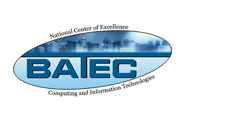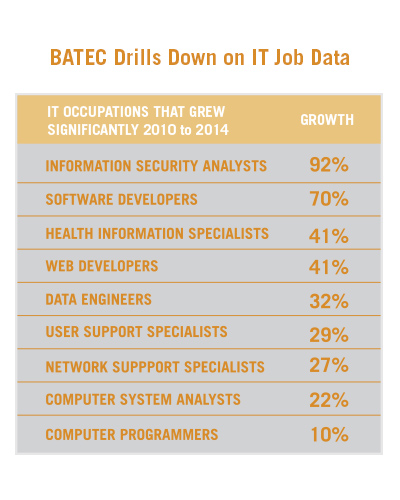
BATEC
Broadening Advanced Technological Education Connections
Boston, Massachusetts
www.batec.org
Contact
Deborah Boisvert
Principal Investigator (PI)
deborah.boisvert@umb.edu
(617) 287-7295

BATEC’s Research Identifies IT Career Opportunities
Employers depend on a robust supply of qualified and capable talent in order to grow their businesses and achieve their strategic objectives. To address this need, BATEC conducts research to improve understanding of IT middle-skill career pathways. For example, in 2015 BATEC personnel co-authored Middle Skill Employment: Understanding the Opportunities and Skill Requirements for an IT Workforce with Burning Glass Technologies.
This collaboration analyzed the dimensions and characteristics of the workforce opportunities for middle-skill IT professionals. The resulting report includes total employment, number of middleskill positions, number of new jobs, and average compensation on national and regional bases. Its outline of workforce characteristics covers job responsibilities, technical skills, professional skills, and industry certifications.
The nine occupational groups examined in this report constitute an important cross section of the labor market. Together, they accounted for 1.7 million job postings in 2014, or about 10% of all job postings. BATEC’s in-depth analysis of national and regional labor markets has fostered discussions about the underlying dynamics of middle-skill employment and an opportunity to rethink how to source new talent.
BATEC Strengthens IT Technician Pipeline
BATEC’s comprehensive strategy addresses recruitment of underrepresented populations and development of academic pathways. The center promotes understanding of the dynamic nature of IT knowledge, skills, and attributes. It supports intensive curriculum adaptation and development and initiates pedagogical transformation.
BATEC seeks to increase the robustness of the IT technician pipeline and the capacity of individuals moving along it by reaching out to underrepresented and at-risk student populations, and encouraging substantive dialogue among the key stakeholders.
Productive interactions among stakeholders in education, industry, government, and community have resulted in stackable credentials and seamless pathways from high schools to two-year and four-year degree programs.



